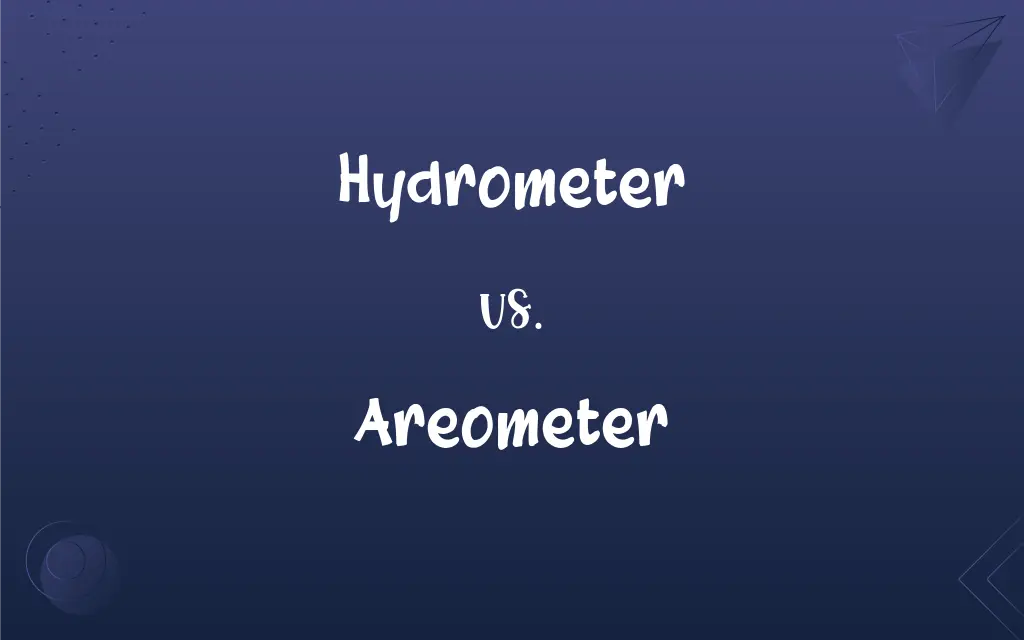Hydrometer vs. Areometer: What's the Difference?
Edited by Aimie Carlson || By Janet White || Updated on February 5, 2024
A hydrometer measures the density of liquids, while an areometer is a type of hydrometer used for broader applications.

Key Differences
A hydrometer is a scientific instrument designed specifically to measure the density (or specific gravity) of liquids relative to water. An areometer is essentially the same device but is often used in a broader context to include measurements beyond just water-based solutions, covering various types of liquids and even granular materials.
Both hydrometers and areometers operate on the principle of buoyancy, determining the density of a liquid based on how an object floats within it. While the term "hydrometer" is more commonly associated with applications in chemistry, brewing, and winemaking to measure the sugar content of a solution, "areometer" is used in a wider array of fields, including industrial applications, to measure densities of different substances.
The differentiation between a hydrometer and an areometer is subtle and more about the context of usage rather than the function or design of the instrument. Hydrometers are typically calibrated for specific types of measurements, such as alcohol content in brewing. In contrast, areometers might be calibrated for a range of densities to accommodate different materials.
In practical terms, the distinction between these instruments is often academic, with "hydrometer" being the term more frequently encountered in specific scientific and hobbyist literature. The term "areometer" might be used in more specialized or industrial contexts, indicating a tool designed for broader applications.
Despite the nuanced differences in terminology, both hydrometers and areometers serve the essential function of measuring the density of liquids. The choice between terms often reflects the specific application or industry standard, but both instruments share the same fundamental principles and operational methods.
ADVERTISEMENT
Comparison Chart
Primary Use
Measures density of liquids
Measures density of liquids and other materials
Application Context
Brewing, winemaking, chemistry
Broad industrial and scientific use
Specificity
Often specific to a type of liquid
Designed for a range of densities
Common Usage
More common in specific fields
Used in specialized or broader contexts
Terminology Preference
Preferred in hobbyist literature
Might be preferred in industrial applications
ADVERTISEMENT
Hydrometer and Areometer Definitions
Hydrometer
Used in winemaking to determine sugar content.
By measuring the must with a hydrometer, the winemaker could predict the wine's alcohol content.
Areometer
A device for measuring the density of various substances.
The quality control department used an areometer to ensure the consistency of the industrial fluids.
Hydrometer
Determines the salinity in aquariums.
Aquarists use a hydrometer to ensure the right salinity level for marine tanks.
Areometer
Determines the density of granular materials and liquids.
To analyze the composition of the new material, the technician utilized an areometer.
Hydrometer
Assesses battery fluid density.
The mechanic checked the car battery's health using a hydrometer.
Areometer
Used across different industries for quality assessment.
In the food industry, an areometer checks the density of syrups and oils.
Hydrometer
Measures the specific gravity of liquids.
The brewer used a hydrometer to check the beer's fermentation progress.
Areometer
Measures the specific gravity of a wide range of liquids.
The lab technician used an areometer for a quick assessment of the chemical's density.
Hydrometer
Helps in soil analysis by measuring the density of soil solutions.
Researchers employed a hydrometer to study the nutrient concentration in the soil solution.
Areometer
Helps in environmental testing by assessing water salinity and pollution levels.
Environmental scientists use an areometer to monitor water quality in lakes and rivers.
Hydrometer
An instrument used to determine specific gravity, especially a sealed, graduated tube, weighted at one end, that sinks in a fluid to a depth used as a measure of the fluid's specific gravity.
Areometer
Any device used to measure the specific gravity of liquids or the density of solids.
Hydrometer
An instrument that floats in a liquid and measures its specific gravity on a scale.
Areometer
An instrument for measuring the specific gravity of fluids; a form hydrometer.
Hydrometer
An instrument for determining the specific gravities of liquids, and thence the strength spirituous liquors, saline solutions, etc.
Hydrometer
An instrument, variously constructed, used for measuring the velocity or discharge of water, as in rivers, from reservoirs, etc., and called by various specific names according to its construction or use, as tachometer, rheometer, hydrometer, pendulum, etc.; a current gauge.
Hydrometer
A measuring instrument for determining the specific gravity of a liquid or solid
FAQs
What is an areometer?
An areometer is a type of hydrometer used to measure the density of various substances, including liquids and granular materials.
Is there a difference between a hydrometer and an areometer?
The difference is mainly in the application scope; hydrometers are often specific to liquids, while areometers have broader applications.
How does a hydrometer work?
A hydrometer works by floating in a liquid, and the level to which it sinks indicates the liquid's density.
What is a hydrometer?
A hydrometer is an instrument for measuring the density of liquids compared to water.
Can an areometer measure the density of solids?
An areometer can measure the density of granular materials suspended in liquids, not solid objects in their compact form.
What does specific gravity mean in the context of a hydrometer?
Specific gravity, measured by a hydrometer, is the ratio of the density of a liquid to the density of water.
When would you use a hydrometer?
You would use a hydrometer in brewing, winemaking, or chemistry to measure liquid densities.
Can a hydrometer measure alcohol content?
Yes, a hydrometer can measure potential alcohol content in brewing and winemaking by assessing sugar density.
What industries use areometers?
Industries such as food processing, environmental science, and manufacturing use areometers for quality control and analysis.
How do you read a hydrometer?
You read a hydrometer by observing where the surface of the liquid intersects the scale on the instrument.
When is an areometer used?
An areometer is used in various industries to measure the density of different substances, including fluids and granular materials.
Are hydrometers and areometers calibrated differently?
Yes, they can be calibrated differently depending on their specific applications and the range of densities they measure.
Can I use an areometer for home brewing?
Yes, an areometer can be used for home brewing to measure the density of brews, though hydrometers are more common for this specific application.
Can temperature affect hydrometer readings?
Yes, temperature can affect density and thus hydrometer readings; many hydrometers come with temperature correction charts.
What materials are hydrometers and areometers made from?
They are commonly made from glass and may contain a weighted bulb with a scale.
Can a hydrometer measure sugar content?
Yes, a hydrometer can measure sugar content in a solution, indicating potential alcohol content in winemaking and brewing.
How accurate are hydrometers and areometers?
Their accuracy can vary based on the quality of the instrument and the precision of its calibration.
Do hydrometers and areometers require maintenance?
Yes, they should be cleaned and stored properly to ensure accuracy and longevity.
Is training required to use a hydrometer or areometer?
Basic understanding is required, but no formal training is needed for general use.
Can digital hydrometers or areometers be more accurate?
Digital versions can offer more precise readings and easier use, depending on the model and application.
About Author
Written by
Janet WhiteJanet White has been an esteemed writer and blogger for Difference Wiki. Holding a Master's degree in Science and Medical Journalism from the prestigious Boston University, she has consistently demonstrated her expertise and passion for her field. When she's not immersed in her work, Janet relishes her time exercising, delving into a good book, and cherishing moments with friends and family.
Edited by
Aimie CarlsonAimie Carlson, holding a master's degree in English literature, is a fervent English language enthusiast. She lends her writing talents to Difference Wiki, a prominent website that specializes in comparisons, offering readers insightful analyses that both captivate and inform.
































































